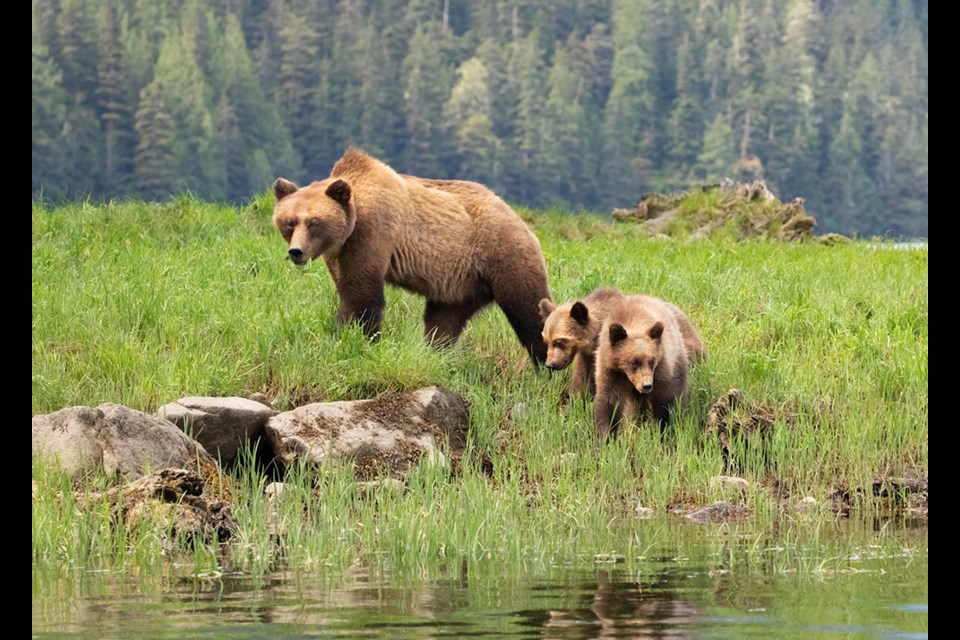An emaciated grizzly was found dead yesterday on the B.C. Central Coast yesterday, sparking concern over the rest of the bear population and its food supply.
The bear was found at Smith Inlet, about 60 kilometres north of Port Hardy in the traditional territory of the Gwa’sala-‘Nakwaxda’xw First Nation, by a Gwa’sala-‘Nakwaxda’xw team on a river patrol near Nekite River estuary.
“The poor bear starved to death,” said John Smith, a fisheries supervisor with the band and the one who found the dead grizzly. Smith said there are very few fish in the river right now, adding he saw five other bears who seemed “thinner than normal” but not as bad as the dead one.
‘I’ve never seen anything like this before,” said Patricia Sewid, a Gwa’sala-‘Nakwaxda’xw fisheries officer.
While Sewid returned to Port Hardy last week she said that she had counted the lowest salmon numbers of her career.
“Eight days ago I counted just over 300 pinks, ideally I should have counted over 10,000,” said Sewid.
The low number of salmon is not helping the bears, she said and added that this year she observed a low count of berries too – another food source.
The Smith Inlet team is used to observing grizzlies on a regular basis in their territory. When the grizzlies come out of hibernation from April to May, they are usually skinny and they gain weight in a couple of weeks, said Sewid. But seeing an emaciated grizzly in September is alarming.
Tom Rivest, a guide and co-owner of the Great Bear Lodge, who is familiar with the grizzly population in these areas has said that it is difficult to conclude anything definitively without a necropsy, as the bear could also have some underlying condition which prevented it from feeding.
But he also said that the salmon numbers are very low and berry crops were patchy this year. Some of the bears he observed seemed to be in good shape while many are just “getting by.”
“The challenge is, we only see a few per cent of the habitat the bears use, so a lot of our observations allow only limited conclusions,” said Rivest.
This is not the first time the image of an emaciated grizzly has caused concern for a First Nation. Last year, Broughton’s grizzlies received global attention after a photographer shared images of emaciated grizzlies from the traditional territory of the Mamalilikulla First Nation.
Since there was hardly any salmon in Hoeya Sound and Lull Bay, the First Nation took matters into its own hands and fed more than 500 salmon carcasses they ordered from a hatchery to the bears – an act that got the First Nation in a tight spot with conservation officers and the Ministry of Forests.
Jake Smith the Mamalilikulla guardian watchman program manager told Black Press Media that this year too they have a grizzly in Lull Bay that “doesn’t look too good.”
Jake received the images of the emaciated grizzly from Smith Inlet from a fellow guardian watchman yesterday.
“There was nothing worse than seeing that picture,” said Jake.
He also said that he has been receiving images of emaciated grizzlies from across the province this year. A couple of months ago, he received an image of an emaciated grizzly from Little Nemo Bay.
“First Nations are slowly losing our resources like salmon, which has a huge domino effect on our wildlife. If we have no salmon, then we have no bears, eagles, whales, no tourism industry etc,” said Jake.
He also said that the guardian watchmen have communicated some of these concerns along with other issues they’ve come across while patrolling through their traditional territories to the authorities but there has neither been any response nor collaborative efforts.
“It seems like the authorities don’t want to do anything about it,” said Jake and added, “they’ll slap your hands and say ‘that’s not right’ when you take matters into your own hand or say that these deaths are just ‘natural’.”
He said that grizzlies starving and dying indicated a serious problem and studies need to be undertaken to see what the real problem is.
“When a grizzly dies of starvation it’s not natural, it’s a man-made disaster,” said Jake and added that conservation officers and DFO need to buckle up and find out what is going on.
This article was originally published by the Campbell River Mirror as part of the Local Journliasm Initiative.







